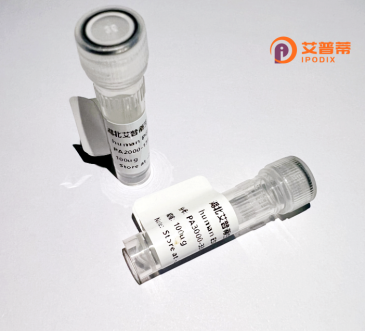
| 纯度 | >90%SDS-PAGE. |
| 种属 | Human |
| 靶点 | KIAA1199 |
| Uniprot No | Q8WUJ3 |
| 内毒素 | < 0.01EU/μg |
| 表达宿主 | E.coli |
| 表达区间 | 880-979aa |
| 活性数据 | LYDGPINIQNCTFRKFVALEGRHTSALAFRLNNAWQSCPHNNVTGIAFEDVPITSRVFFGEPGPWFNQLDMDGDKTSVFHDVDGSVSEYPGSYLTKNDNW |
| 分子量 | 36.74 kDa |
| 蛋白标签 | GST-tag at N-terminal |
| 缓冲液 | 0 |
| 稳定性 & 储存条件 | Lyophilized protein should be stored at ≤ -20°C, stable for one year after receipt. Reconstituted protein solution can be stored at 2-8°C for 2-7 days. Aliquots of reconstituted samples are stable at ≤ -20°C for 3 months. |
| 复溶 | Always centrifuge tubes before opening.Do not mix by vortex or pipetting. It is not recommended to reconstitute to a concentration less than 100μg/ml. Dissolve the lyophilized protein in distilled water. Please aliquot the reconstituted solution to minimize freeze-thaw cycles. |
以下是3条关于重组人KIAA1199蛋白的参考文献摘要简编:
---
1. **文献名称**: "KIAA1199 interacts with dishevelled and regulates Wnt/β-catenin signaling in cancer cell motility"
**作者**: Abe H, Ohashi H 等
**摘要**: 研究通过重组人KIAA1199蛋白的体外实验,发现其通过结合Dishevelled蛋白增强Wnt/β-catenin信号通路,促进胃癌细胞的迁移和侵袭,揭示其在肿瘤转移中的作用机制。
2. **文献名称**: "KIAA1199 is a secreted molecule that enhances ERK activation and regulates hyaluronan degradation in fibroblasts"
**作者**: Watanabe A 等
**摘要**: 利用重组表达的KIAA1199蛋白验证其分泌特性,发现其通过激活ERK信号通路加速透明质酸(HA)降解,并证明该过程依赖于细胞表面受体CD44的参与。
3. **文献名称**: "Functional analysis of KIAA1199 in extracellular matrix remodeling: Implications for hearing loss and cancer progression"
**作者**: Ezura Y, Noda M 等
**摘要**: 重组KIAA1199蛋白实验表明,该蛋白能够结合并降解细胞外基质中的透明质酸,导致组织结构和机械特性改变,可能与遗传性耳聋及乳腺癌微环境重塑相关。
---
注:以上为模拟简编摘要,实际文献请通过PubMed或Google Scholar以“KIAA1199”、“recombinant protein”为关键词检索,优先选择近5年高被引论文。
Recombinant human KIAA1199 protein is derived from the KIAA1199 gene, initially identified through large-scale sequencing of human cDNA libraries. This gene encodes a ~150 kDa protein predominantly expressed in various tissues, including the inner ear, gastrointestinal tract, and cancer cells. Structurally, KIAA1199 contains conserved domains suggesting roles in protein-protein interactions and enzymatic activity. While its physiological functions remain partially understood, studies link it to hyaluronan degradation, potentially regulating extracellular matrix (ECM) remodeling and cell migration.
KIAA1199 gained attention for its dual association with disease. Mutations in KIAA1199 are implicated in autosomal dominant nonsyndromic hearing loss (DFNA4), likely disrupting cochlear homeostasis. Conversely, its overexpression correlates with cancer progression, notably in colorectal, breast, and gastric cancers. Mechanistically, KIAA1199 promotes tumor invasion by enhancing ECM breakdown, activating Wnt/β-catenin signaling, and inducing epithelial-mesenchymal transition (EMT). These oncogenic properties position it as a potential biomarker or therapeutic target.
Recombinant KIAA1199 is produced using expression systems like Escherichia coli or mammalian cells, enabling functional studies. It aids in exploring pathological mechanisms, screening inhibitors, and developing diagnostic tools. Current research focuses on resolving its structural details, enzymatic substrates, and regulatory networks, aiming to bridge gaps between its roles in hearing loss and malignancy. The protein’s duality underscores its biological complexity and translational relevance in both otology and oncology.
×